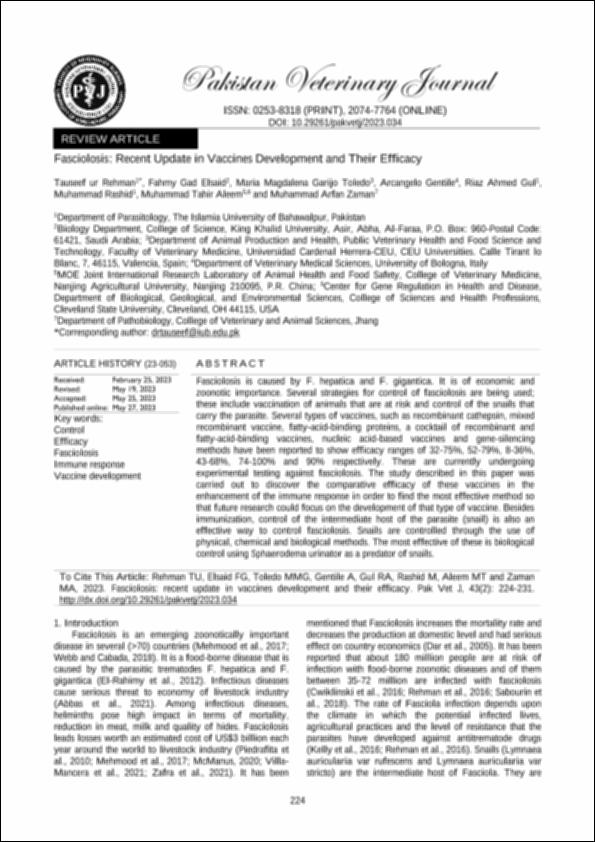Por favor, use este identificador para citar o enlazar este ítem:
http://hdl.handle.net/10637/14488Fasciolosis : recent update in vaccines development and their efficacy
| Título : | Fasciolosis : recent update in vaccines development and their efficacy |
| Autor : | Rehman, Tauseef ur Elsaid, Fahmy Gad Garijo Toledo, María Magdalena Gentile, Arcangelo Gul, Riaz Ahmed Rashid, Muhammad |
| Materias: | Fascioliasis - Vaccination.; Veterinary vaccines.; Fascioliasis - Vacunación.; Vacunas veterinarias. |
| Editorial : | University of Agriculture, Faculty of Veterinary Science |
| Citación : | Rehman, T.U., Elsaid, F.G., Garijo Toledo, M.M., Gentile, A., Gul, R.A., Rashid, M., Aleem, M.T. & Zaman, M.A. (2023). Fasciolosis: recent update in vaccines development and their efficacy. Pakistan Veterinary Journal, vol. 43, i. 2 (apr.), pp. 224-231. DOI: http://dx.doi.org/10.29261/pakvetj/2023.034 |
| Resumen : | Fasciolosis is caused by F. hepatica and F. gigantica. It is of economic and zoonotic importance. Several strategies for control of fasciolosis are being used; these include vaccination of animals that are at risk and control of the snails that carry the parasite. Several types of vaccines, such as recombinant cathepsin, mixed recombinant vaccine, fatty-acid-binding proteins, a cocktail of recombinant and fatty-acid-binding vaccines, nucleic acid-based vaccines and gene-silencing methods have been reported to show efficacy ranges of 32-75%, 52-79%, 8-36%, 43-68%, 74-100% and 90% respectively. These are currently undergoing experimental testing against fasciolosis. The study described in this paper was carried out to discover the comparative efficacy of these vaccines in the enhancement of the immune response in order to find the most effective method so that future research could focus on the development of that type of vaccine. Besides immunization, control of the intermediate host of the parasite (snail) is also an effective way to control fasciolosis. Snails are controlled through the use of physical, chemical and biological methods. The most effective of these is biological control using Sphaerodema urinator as a predator of snails. |
| Descripción : | Este artículo se encuentra disponible en la siguiente URL: http://pvj.com.pk/pdf-files/23-053.pdf En este artículo también participan: Muhammad Tahir Aleem y Muhammad Arfan Zaman. |
| URI : | http://hdl.handle.net/10637/14488 |
| Derechos: | http://creativecommons.org/licenses/by-nc/4.0/deed.es |
| ISSN : | 0253-8318 2074-7764 (Electrónico) |
| Idioma: | es |
| Fecha de publicación : | 30-abr-2023 |
| Centro : | Universidad Cardenal Herrera-CEU |
| Aparece en las colecciones: | Dpto. Producción y Sanidad Animal, Salud Pública Veterinaria y Ciencia y Tecnología de los Alimentos |
Los ítems de DSpace están protegidos por copyright, con todos los derechos reservados, a menos que se indique lo contrario.


